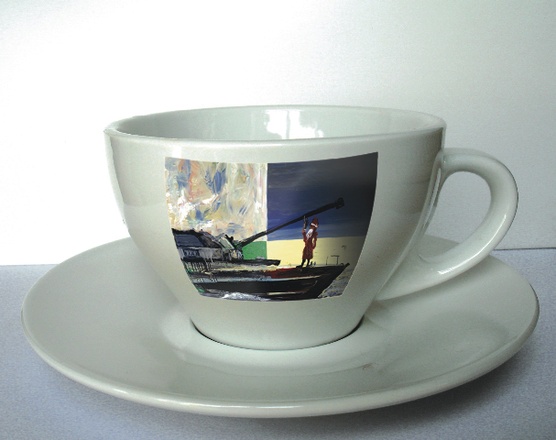Martin Kippenberger Tasse / Martin Kippenberger Cup
(2007)
Fighting fire with fire – in the heat of this year’s art summer “Texte zur Kunst” recommends to take a sip from the Kippenberger cup!
It was Martin Kippenberger who generously supported the first issue of this magazine in December 1990 with an artist’s edition. Modeled on a photograph, Kippenberger had the head of the then Federal President of Germany, Richard von Weizsäcker, carved in wood. He then cut the head into 100 pieces to produce the same amount of key-ring pendants. The title of the work was “Vom Scheitel bis zur Speiseröhre Modell Richie [From the Part to the Gullet Model Richie]”. Of course, this edition has long been sold out. In retrospect, the work prophesied that “Texte zur Kunst” would one day become “official”, an institution, and at the same time made fun of our claim to, from now on, set the tone in art criticism. But with Weizsäcker, Kippenberger also forced upon us a monument of official state representation and a national symbol, only to then destroy it in the same breath.
This issue of “Texte zur Kunst” again presents an edition that is connected with the name of Kippenberger. How is it that, ten years after Kippenberger’s death, we ourselves conceive a “Kippenberger” work, which, by the way, was authorized by the administrators of his estate? The relationship between Kippenberger and this magazine was always characterized by mutual respect and goodwill, but also by conflicts and power struggles. Directly after his death, we talked with a number of persons who were close to him so as to do justice to the overlapping of work and person which was typical of Kippenberger. On the other hand, we addressed in a more critical way the posthumous reception of the artist, which in recent years has transfigured him into a painter-genius and neglected the institution-critical orientation of his procedures as well as the insolence his provocative coquetting with sexist and racist rhetoric occasionally posed for his audience.
In view of the fact that currently all members of the art business can agree on the name “Kippenberger”, and a sort of “Picasso” effect (establishment of a myth meets museum merchandizing) seems to have commenced, we would like to anticipate the end of this development, something which he would have wished: we had cups and saucers produced with one of Kippenberger’s motifs that is especially catchy and therefore circulates most successfully: “Krieg Böse [War Evil]”. Due to the title, one wanted to see in the painting from 1983 a sort of memorial against political correctness (which is today again fought against everywhere). We, however, believe that this painting functions more complexly: just as it makes fun of the simplifying scheme of “good” and “evil”, it hits out at the regressive, presumptuous energy of warmongers. We selected the type of cup with which Kippenberger himself posed on the invitation card to the show “M.K.-4 Bilder” at Galerie Gerald Just in Hanover in May 1984.
Corresponding with Kippenberger’s special liking of social situations, we conceived sets consisting of 4 cups and saucers. The motif of “Krieg Böse” is printed in color on each cup. The center of each saucer is decorated with the title in black. There are 120 sets at a price of 100 euros each.
(Translation: Karl Hoffmann)

